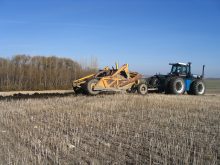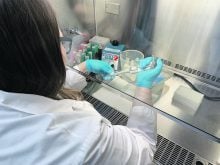Latest technology stacks more genes, like adding digits to the combination lock that protects your crop
Wheat stem rust is a killer, one of the world’s most devastating diseases, with a history of massive rust plagues dating back 2,000 years. But a new variety holds hope.
The new strain has been named Big Five by the research team because it’s the first time breeders have successfully installed five stable genes in a strain of wheat to build resistance to (Puccinia graminis) stem rust resistant strain.
But the breakthrough represents more than just a new working variety. It also introduces a whole new way to bring desirable traits into future wheat strains.
Read Also

Fusarium head blight mycotoxin detector in the works
A PhD student at the University of Saskatchewan has been working on developing a method of detecting fusarium damaged kernels to ease the struggles of producers, agronomists and industry.
Development of Big Five was partially funded by the 2Blades Foundation, a non-profit global plant research organization that regularly distributes their newly developed technologies at no cost to national and international agencies or even local seed companies.
Wheat growers are well aware that the stem rust pathogen is capable of totally destroying a crop in a matter of weeks. The foundation says the new strain shows exceptional resistance to wheat stem rust. They emphasize that the most effective and environmentally benign way to control wheat rust is with genetic resistance, not chemicals.
Through the 1960s, the recurring threat to wheat had been managed successfully through Norman Borlaug’s varieties introduced during the Green Revolution. Borlaug was an American agronomist and winner of the 1970 Nobel Peace Prize who led initiatives worldwide contributing to major increases in agricultural production.
But Mother Nature always prevails and Borlaug’s rust-free varieties eventually succumbed to pathogens that evolved to overcome the resistance. So once again the disease threatens wheat yields around the globe. But this time, there will be a rust resistant wheat strain that can defend its valuable pathogen resistant characteristic.
An Australian research team recently developed a new rust resistant variety by identifying five resistant genes to build a gene stack and insert it into a single location in the genome of a common wheat variety. The resistance genes are stacked to build what they call “durable resistance to wheat stem rust.”
One of the breeders commented that gene-stacking technology is like adding digits to the combination lock that protects your wheat from disease. It will take nearly forever for the Puccinia graminis to break the codes.
2Blade explains that the stable gene stack represents an advance over conventional wheat breeding methods. In conventional breeding, development of an equivalent disease-resistant wheat would require a long succession of crosses. And there’s always the risk that the resulting resistance could be lost in subsequent crosses.
2Blades president and cellular biologist Diana Horvath explains, “The new gene stacking approach collects five individual genes resistant to rust and assembles them rapidly into a single stack The stack is then introduced into a chosen wheat line. This eliminates time-consuming breeding efforts that may be unstable or short-lived.
“It also ensures that the desirable trait, as determined by multiple genes, will not be lost in subsequent breeding. The Canberra research targeted wheat stem rust, but the same technology is being used to create durable resistance for wheat stripe and leaf rust diseases which also attack wheat crops.”
In future, gene stacks could be prepared with genome-editing tools to develop improved crops that may be considered non-genetically modified in some countries.
Wheat provides about 20 percent of calories and protein for human nutrition worldwide and is the third largest crop grown in the United States. The most effective and environmentally sound way to defend against wheat rust diseases is through the deployment of resistance genes in wheat varieties. This is particularly important in developing countries where the fungicides used to combat rust disease may be expensive or unavailable.
International adoption of rust-resistant wheat varieties is essential because rust fungi produce trillions of spores that can be carried by winds for thousands of miles, even across oceans, thus infecting vulnerable wheat crops around the globe.
Horvath say Big Five will not go directly into the market place. 2Blade considers it a working strain they can share with other like-minded wheat breeders. Because of the quicker pace at which new varieties are developed, she says it won’t be long before these genetic benefits will be available to Canadian farmers.
















